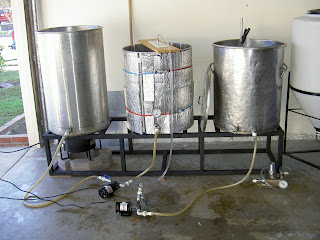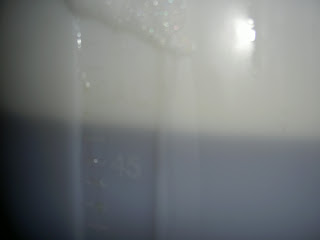I kegged up 43 gallons of the Blonde ale last weekend (6/15). Now that I have an idea what my fermenting losses are, I can adjust my future batch sizes accordingly. Eventually I want to get 46.5 gallons out of the fermenter so I can get three full sized standard kegs per brew. For this batch I estimated I'd loose about 1.5 gallons of beer but in reality I ended up loosing 2.5 gallons with the various yeast dumps and another 1 gallon left behind in the fermenter. I didn't have any spare growlers around or else I would have tried to get that out. By then it was after 1:00 in the morning and I was done.
Final gravity was 1.008, which is a little lower than I was shooting for, but not unexpected after the long mash at a low temperature and essentially open fermentation. ABV was 6.07%.
I sampled some of it later in the week and I have high hopes for it! It should be really coming into its own by the time our July 4th block party rolls around.
The pumps are now mounted to the frame and I have made a few other minor adjustments. I have a few more things I'd like to do before getting another batch going. That batch will be an Old Ale and one that ages nicely so it will be nice to have a few extra kegs of it around.
 Top left is the main power switch. The temp controller on the left is for the mash tun and the one on the right is for the hot liquor tank. The two switches on the bottom are for the pumps. I have a couple of status lights I want to wire in to indicate when the burners are lit.
Top left is the main power switch. The temp controller on the left is for the mash tun and the one on the right is for the hot liquor tank. The two switches on the bottom are for the pumps. I have a couple of status lights I want to wire in to indicate when the burners are lit.













